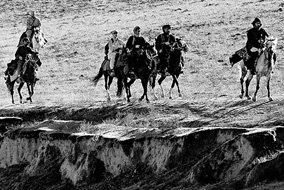 Horse Soldiers. Didn’t John Wayne star in that movie?
Horse Soldiers. Didn’t John Wayne star in that movie?
It’s hard to imagine anyone better for the role of Captain Mitch Nelson than the Duke. But Horse Soldiers isn’t a movie. It’s a recently published book by Doug Stanton about a small band of U.S. Special Forces that rode horseback with Afghanistan’s Northern Alliance into battle against the Taliban in 2002.
Few of Nelson’s men had been near a horse before they landed in Afghanistan and climbed aboard scrawny, unshod mounts provided by General Abdul Rashid Dostum of the Northern Alliance. The saddles, built for the average Afghan man who weighed 140 pounds, were made of three boards hinged together and covered with goatskin. The stirrups were hammered iron rings attached to the saddle with short leather straps.
Riding with knees next to their elbows and each carrying 300 pounds of weapons, ammo and gear, the men traversed the Hindu Kush Mountains, rising 25,000 feet above the desert, on two-foot wide trails laden with mines and with 1,000-foot drops. After the first climb, upon dismounting most had trouble standing up straight. Some had blood seeping through the seat of their pants, where the saddle had rubbed the skin away.
Nelson’s and Dostum’s mission was to take Maza-i-Sharif from the Taliban with the help of U.S. Air Force bomb strikes on the enemy’s big guns. Before Nelson’s arrival, Dostum’s forces had ridden their horses into sheets of fire from Taliban artillery, backed by tanks, mortars, and machine guns.
During preparations for their first joint battle with 1,500 mounted soldiers, Nelson asked Dostum how the horses would react when the bombs started dropping.
“They will not be nervous,” Dostum assured him.
“Why not?” Nelson wanted to know.
“Because they know that these are American bombs,” said Dostum.
Although they didn’t mind bullets whizzing past them, the horses did buck and rear at the boom and roar of the bombs. But the Afghans rode ahead at a full gallop with reins clamped in their teeth as they fired over the necks of their mounts. When they dismounted, they threw their reins to the ground and stood on them while they fired their rifles.
“The capture of Maza-i-Sharif with fewer than 350 Special Forces, 100 CIA officers and 15,000 Afghans accomplished in two months what the Pentagon had said would take two years – the defeat of 60,000 Taliban fighters,” Stanton points out at the end of the book.
From start to finish, Horse Soldiers is one hell of a ride.
